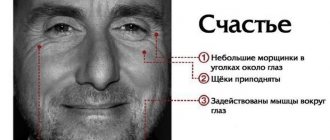Types of emotions and their general characteristics
There are different types of emotions. Emotions and feelings vary depending on their quality
(positive and negative),
depth, intensity and duration of influence on activities.
The qualitative uniqueness of emotions and feelings expresses how a person relates to the corresponding phenomenon. Depending on how significant and how reality is reflected in emotions and feelings, deep
and
shallow
emotions and feelings.
Depending on the influence on activity, emotions and feelings are divided into sthenic
(from the gr. sthenos - strength) and
asthenic
. Stenic feelings encourage active activity and mobilize a person’s strength. Thus, feelings of joy or inspiration stimulate a person to energetic activity. Asthenic emotions relax a person and paralyze his strength.
By content originality
emotions distinguish the following types of emotions (Fig. 2).
Emotional tone of sensation
– our attitude to the quality of sensation, a mental reflection of the need properties of an object. Various sensations (smells, colors, sounds, etc.) are pleasant, neutral or unpleasant for a person.
| Mood |
| A long-term emotional state that does not reach significant intensity and does not have significant fluctuations over a long period |
| Extremely expressed but short-lived emotion |
| A fairly long-lasting and intense emotion that has a certain significance for a person |
| Emotional reaction to danger |
| Mental state of general excitement, tension during activities in difficult, unusual, extreme conditions; nonspecific reaction of the body to sharply changing environmental conditions |
| Features of experiences and behavior as a result of difficulties encountered on the way to achieving a goal |
| Emotional response |
| This is an emotional immediate reaction to current changes in the subject environment. |
| Emotional tone |
| Attitude to the quality of sensation, mental reflection of the need properties of an object |
| Affect |
| Fear |
| Passion |
| Frustration |
| Stress |
| Types of emotions |
Rice. 2. Types of emotions
We like the smell of flowers, the sound of the sea surf, the color of the sky at sunset, but the smell of rot and the grinding of brakes are unpleasant. There is even a painful organic aversion to certain stimuli - idiosyncrasy (for example, to the sounds made by a metal object grinding on glass).
The emotional attitude towards vital influences is inherited. This allows the body to react to it already at the first meeting with a harmful object. The emotional tone of various influences, fixed in memory, is then included in various perceptions and ideas. Emotional memory and a person’s emotional experience play a significant role in cases where it is necessary to act in conditions of a deficit of conceptual information.
Emotional response
– this is an emotional operational reaction to current changes in the subject environment.
An emotional response is determined by a person’s emotional excitability, his emotional tone; one of the types of emotional response is syntony
- empathy for the emotional state of other people - the most important social quality of a person. The ability for emotional consonance depends on the conditions of upbringing. People brought up in conditions of insufficient emotional contact or satiety with emotional contacts become incapable of emotional empathy.
Mood
is a general emotional state that colors a person’s behavior over a significant period of time.
Mood depends on the general state of health, the functioning of the endocrine glands, and the vital tone of the body. It is an emotional reaction not to the immediate consequences of certain events, but to their significance in a person’s life in the context of his life plans, interests and expectations. Mood, like all other emotional states, can be positive and negative, have a certain intensity, severity, tension and stability.
Affect
(
from the Latin affectus - emotional excitement, passion) is an excessive neuropsychic overexcitation that suddenly arises in an acute conflict situation, manifested in temporary disorganization of consciousness (its narrowing) and extreme activation of impulsive reactions.
Affect is an emotional explosion in an acute conflict situation, the danger of personal defeat. Deep resentment from a grave insult to a person, the sudden emergence of danger, gross physical violence - all these circumstances, depending on the individual characteristics of the person, can cause affect.
The state of affect is characterized by a significant disruption of the conscious regulation of human actions. A person’s behavior when affected is regulated not by a premeditated goal, but by a feeling that completely captures the personality and causes impulsive, subconscious actions. In a state of passion, the most important mechanism of activity is disrupted - selectivity in the choice of a behavioral act, a person’s behavior changes sharply, his attitudes and life positions are deformed, the ability to establish relationships between phenomena is disrupted, one, often distorted, idea begins to dominate in consciousness. From a neurophysiological point of view, this “narrowing of consciousness” during affect is associated with a disruption of the normal interaction of excitation and inhibition. The state of affect is associated with disturbances in the clarity of consciousness, which can lead to the inability to subsequently remember episodes of the event that caused the affect, and in the case of exceptionally strong affect, it can result in loss of consciousness and complete amnesia.
Affects associated with negative emotions (anger, hatred, jealousy) often acquire a destructive, aggressive nature, since a person acts reflexively, the latent period from the perception of the stimulus to the response is reduced to a minimum (several milliseconds), so the subject does not have time to realize the meaning and the consequences of their actions.
Passion
- this is a strong, persistent, all-encompassing feeling that dominates other impulses and leads to the concentration of all aspirations and forces on the subject of passion.
In terms of the intensity of emotional arousal, passion approaches passion, and in terms of duration and stability it resembles mood. The main sign of passion is its effectiveness, the fusion of volitional and emotional moments. Passion, having great power, is one of the essential motivations for activity. The unity of the moral, rational principle and passion is often the driving force behind great deeds, exploits, and discoveries.
Fear
- an unconditional reflexive, emotional reaction to danger, manifested in a sharp change in the vital activity of the body.
Fear arose as a biological defense mechanism. In most cases, fear causes a strong sympathetic discharge: screaming, running, grimacing. A characteristic symptom of fear is trembling of the body muscles, dry mouth (hence the hoarseness and muffled voice), a sharp increase in heart rate, increased blood sugar, etc. In this case, the hypothalamus begins to secrete neurosecretion, which stimulates the pituitary gland to release adrenocorticotropic hormone.
Socially determined causes of fear are the threat of public censure, loss of labor results, humiliation, etc. – cause the same physiological symptoms as biological sources of fear.
The highest degree of fear, turning into affect, is horror.
Terror is accompanied by a sharp disorganization of consciousness (insane fear), numbness (it is assumed that it is caused by an excessively large amount of adrenaline) or erratic muscle overexcitation (“motor storm”).
In a state of horror, a person may exaggerate the danger of an attack; his defense may be excessive, incommensurate with the real danger. The emotion of fear caused by dangerous violence encourages unconditional reflexive response actions based on the instinct of self-preservation.
Fear is a passive defensive reaction to danger, often emanating from a stronger person. If the threat of danger comes from a weaker person, then the reaction may acquire an aggressive, offensive character - anger.
In a state of anger, a person is predisposed to instant, often impulsive action. Excessively increased muscle excitation with insufficient self-control easily turns into very strong action. Anger is accompanied by threatening facial expressions and an attack pose. In a state of anger, a person loses objectivity of judgment and carries out uncontrollable actions. Fear and anger can reach the level of affect, but sometimes they are expressed in a lesser degree of emotional stress.
Stress
(from the English stress - tension) is an emotional state that occurs in response to extreme influences.
Stress is a total mobilization of the body’s forces to find a way out of a very difficult, dangerous situation, to adapt to extremely difficult conditions. Extremely strong irritants - stressors cause vegetative changes (increased heart rate, increased blood sugar, etc.), the body prepares for intense actions. In response to an extremely difficult situation, a person reacts with a complex of defensive reactions.
Physiological stress
is a total mobilization of the body’s forces to find a way out of a very difficult, dangerous situation, to adapt to extremely difficult conditions. In response to an extreme situation, a person reacts with a complex of defensive reactions. Under physiological stress, the human body responds not only with a defensive reaction (change in adaptive activity), but also with a complex generalized reaction, often little dependent on the specifics of the influencing stimulus.
Psychological stress
Informational stress and emotional stress are subdivided.
Information stress occurs in situations of information overload, when the subject cannot cope with a task and does not have time to make the right decisions at the required pace.
Emotional stress appears in situations of threat, danger, resentment, etc. At the same time, its various forms (impulsive, inhibitory, generalized) lead to changes in the course of mental processes, emotional shifts, transformation of the motivational structure of activity, disorders of motor and speech behavior.
Sociogenic stress.
Social reality (political, economic, family life, etc.) can be a powerful stress factor for a person. Social stressors can include conflicts of a social and interpersonal nature, loss of a job, obstacles to achieving a goal, etc.
Environmental stress
associated with climatic and geographical conditions of human activity (earthquakes, volcanic eruptions, hurricanes, etc.).
Technogenic stress
due to the danger posed by technology to the lives and activities of people.
Autogenic stress.
The cause of stress, stressors, are certain personality traits (touchiness, suspiciousness, feelings of inferiority, etc.).
Traumatic stress
– these are experiences of an atypical nature, the result of a special interaction between a person and the environment. With traumatic stress, intense negative experiences are possible when a person encounters something resembling a traumatic event.
Work stress
arises due to reasons related to work conditions, place of work.
Professional stress
associated with the conditions, means, technology, mode of implementation of a particular professional activity (pilots, sailors, doctors, journalists, etc.).
Organizational stress
arises due to the negative impact on the employee of the characteristics of the organization in which he works.
A person’s behavior in a stressful situation depends on many conditions, but primarily on his psychological preparation, including the ability to quickly assess the situation, skills of instant orientation in unexpected circumstances, strong-willed composure and determination, experience of behavior in similar situations. Stress can have both a mobilizing effect (austress) and a depressing effect (distress).
Frustration
- a specific emotional state of a person, expressed in the characteristic features of experiences and behavior, caused by objectively insurmountable (or subjectively understood) difficulties on the way to achieving a goal or solving a problem. Frustration is accompanied by a range of mostly negative emotions: anger, irritation, guilt, despair, etc. Frustration experiences have a “pressing” effect on the psyche, reducing the ability for reflection (introspection) and logical analysis of events. Frustration is experienced by a person who feels the hostility of a group (family, professional, educational, etc.); a teenager who does not find understanding, love and support for his plans in his family. A state of frustration can lead to significant changes in the subject’s behavior: either refusal of activity, replacement of real activity with imaginary ones (withdrawal into oneself, into dreams), or to the manifestation of rudeness, aggressiveness in relation to those circumstances that directly act as obstacles, barriers , and in relation to everyone around. The latter is typical for adolescents, who are driven by states of frustration to commit illegal acts. Sometimes frustration leads to self-destruction, a feeling of complete purposelessness and hopelessness of one’s existence, nervous depression and suicide. Therefore, a certain amount of willpower and intellectual activity are necessary so that a person can overcome frustration states and find for himself compensatory meaningful activities that would satisfy his living conditions and communication.
Classification of emotions.
Emotions seem to us to be a kind of coloring of sensations that characterizes our attitude towards one or another quality of an object, in other words, it is the sensual tone of sensations. The main characteristic of emotions is their subjectivity.
The classification of emotions includes emotions themselves, mood and affect, feelings, emotional stress. All emotional states are reflected in a person’s behavioral response.
2 pages, 634 words
Feelings and emotions. Concepts about feelings, emotions and their types. Emotional states. Development of the emotional sphere of personality.
Contents: INTRODUCTION……………………………………………………………………………….3 Feelings and emotions…………………………………………………………… …………….4 Types of feelings and emotions………………………………………….5 Emotional states………………………………………… ….8 Development of the emotional sphere of a person……………………………11 CONCLUSION……………………………………………………………….13 REFERENCES USED… ………………………..14 Introduction. Emotions and feelings, like other mental phenomena, are...











